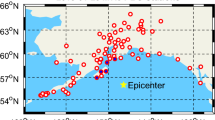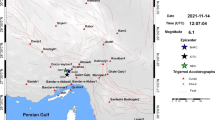Abstract
Earthquake response characteristic and sensitivity of 1-Hz Global Navigation Satellite System - precise point positioning (GNSS-PPP) for a seismic response in time and frequency domains are the main objectives of this study. The Delta and Cairo areas, Egypt, experiencing the shock of the Greece earthquake occurring on April 16, 2015 (18:50 hours), is presented in this study. The results of this study reveal that the seismic wave effect is very small and can be neglected inside the Delta region and the strong motion occurred in an upward direction for the whole monitoring area. Furthermore, the time-frequency analysis illustrates the ability of the time and frequency domains to use and analyze the surface motion based on a 1-Hz sampling frequency and to detect the small- and high-strength motions of seismic waves.








Similar content being viewed by others
References
Ebinuma T, Kato T (2012) Dynamic characteristics of very-high-rate GPS observations for seismology. Earth Planets Space 64:369–377
El-Nabwy M, Kaloop M, Elbeltagi E (2013) Talkha steel highway bridge monitoring and movement identification using RTK-GPS technique. Measurement 46:4282–4292
Emore GL, Haase JS, Choi K, Larson K M, Yamagiwa A (2007) Recovering seismic displacements through combined use of 1-Hz GPSand strong-motion accelerometers. Bull Seismol Soc Am 97(2):357–378. doi:10.1785/0120060153
Geng J (2010) Rapid integer ambiguity resolution in GPS precise point positioning. PhD. Thesis. University of Nottingham, UK
Hefty J, Gerhatova L (2012) Potential of precise point positioning using 1 Hz GPS data for detection of seismic-related displacements. ActaGeodyn. Geomater 3(167):303–313
Hofmann-Wellenhof B, Lichtengegger H, Collins J (2001) GPS Theory and practice, 5th edn. York, Springer-Verlag Wien New
Houlie N, Dreger D, A. K (2014) GPS source solution of the 2004 Parkfield earthquake. Scientific Reports 4:3646. doi:10.1038/srep03646
IGS 2015. International GNSS Service. https://igscb.jpl.nasa.gov/, (May 2015)
Jie M, Yongxiang C, W. X, Yingli Z (2013) A rapid stability assessment of China’s IGS sites after the Ms7. 0 Lushan earthquake. Geodesy and Geodynamics 4(2):11–15
Kaloop MR, Kim D (2014) De-Noising of GPS-structural monitoring observations error using wavelet analysis. Geomatics, Natural Hazards and Risk in press
Li X, M G, Zhang Y, Wang R, Xu P, Wickert J, Schuh H (2013) New approach for earthquake/tsunami monitoring using dense GPS networks. Scientific Reports 3:2682. doi:10.1038/srep02682
Li X, Guo B, C L, Ge M, Wickert J, Schuh H (2014) Real-time GNSS seismology using a single receiver. Geophys J Int. doi:10.1093/gji/ggu113
Martin H (2007) MATLAB recipes for earth sciences, 2nd edn. Springer, Berlin
MATLAB, release 12 [Computer software] (2008) Natick. MA, Mathworks
Moschas F, Stiros S (2011) Measurement of the dynamic displacements and of the modal frequencies of a short-span pedestrian bridge using GPS and an accelerometer. Eng Struct 33(1):10–17
Nikolaidis R M, Bock Y, DeJonge P J, Shearer P, Agnew DC, Domselaar M V (2001) Seismic wave observations with the Global Positioning System. J Geophys Res 106(B10):21897–21916. doi:10.1029/2001JB000329
Ohta Y, Meilano I, Sagiya T, Kimata F, Hirahara K (2006) Large surface wave of the 2004 Sumatra-Andaman earthquake captured by the very long baseline kinematic analysis of 1-Hz GPS data. Earth Planets Space 58:153–157
P Psimoulis, N. Houlie, Meindl M, Rothacher M 2015. Consistency of GPS and strong-motion records: case study of Mw9.0 Tohoku-Oki 2011 earthquake. Smart Struct. Syst., Accepted
Wright T J, Houlié N, Hildyard M, Iwabuchi T (2012) Real-time, reliable magnitudes for large earthquakes from 1 Hz GPS precise point positioning: the 2011 Tohoku-Oki (Japan) earthquake. Geophys Res Lett 39:L12302. doi:10.1029/2012GL051894
Author information
Authors and Affiliations
Corresponding author
Rights and permissions
About this article
Cite this article
Kaloop, M.R., Rabah, M. Time and frequency domains response analyses of April 2015 Greece’s earthquake in the Nile Delta based on GNSS-PPP. Arab J Geosci 9, 316 (2016). https://doi.org/10.1007/s12517-016-2343-8
Received:
Accepted:
Published:
DOI: https://doi.org/10.1007/s12517-016-2343-8




